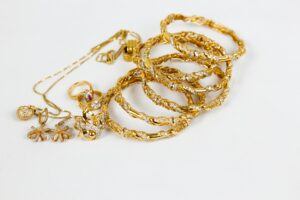How do you know if gold is real or fake? Can you tell the difference between real and fake gold? For most people who are experts in gold worldwide, fake gold is anything that has less than 41.7% or ten karats. Usually, the best way to determine whether gold is real or fake is by having it appraised by a certified jeweler. However, before you decide to use this process, there are some things that you can do to determine whether you have real or fake gold.
The Gold Hallmark
Is there a number on the item of gold that you have? Gold has a stamp known as a hallmark that identifies the percentage of gold in your gold. The stamp can also be found on the clasp of the item you have.

You can also find the stamp on the surface of gold coins and bullion. In some cases, you might need to use a magnifying glass to identify older hallmarks that have been rubbed over time. However, some counterfeits will still include a marking made to appear authentic. As such, it is still important that you get a professional’s opinion before giving the gold as a gift or selling it on the market.
The first number in the hallmark indicates how much gold is in your item. For instance, 25K refers to 99.9% pure gold, 18K is 75% gold, and 14K is 58.5% gold. 10K is 41.7% gold, and anything below that is usually considered fake.
There are also letters on the hallmark that will show you whether the gold item is pure gold or a thin layer of gold on top of another metal. GP means gold plates while GF means gold filled. GEP refers to the items that are gold electroplated.
The Magnet Test
Do you happen to have a magnet lying around? You can check your fridge, and if the item gets attracted to the magnet, it is not gold. As surprising as it may be, gold is not magnetic, and as such, the item you have should not be attracted by the magnet if it is a genuine item made of pure gold.
Wear and Tear
Noticeably wearing out of an item is one of the other indicators that the gold item you have is not what you think. Whenever the item is discolored and spotty, it is not pure gold. An item that has been gold plated, for instance, will tend to scratch easily, and as such, it will get worn out much faster.
Real Gold Does Not React to Oil
For the gold worn on the body, if the area of your skin that was in contact with the item turns green or black, it is not pure gold. Gold does not have the property to react to the oil on the skin. However, silver and copper both can leave behind black and green marks. Some gold items will be a mixture of gold and other items, and these are also known to leave a mark on the skin’s surface.
Real Gold Sinks in Water
Gold is a dense material, and it is so much denser than other metals. For this reason, it is known to sink directly to the bottom of the water quickly. In contrast, fake gold can float or fall more slowly. However, real gold, even when it is in contact with water and has been exposed to the elements for a while, will not tarnish or rust.
This is one of the properties that make it easy to set apart real gold from fake gold. The items will show a slight discoloration of the fake gold when exposed to water. Try dropping the gold item that you have into a bucket full of water, and when it goes directly and quickly right to the bottom, you are confident that you have pure and authentic gold. If it tends to linger in the water in a slow-motion way, then it is not pure gold and is probably a mixture of gold and other less dense materials, which causes it to sink more slowly in the water.
Professional Opinion Still Matters

Even with the methods that have been described in the sections above used to determine if your gold is real or fake, it is still important that you get the honest and practical opinion of a professional. The expert will be able to take the gold through more advanced tests and even print out a report showing the gold’s purity level.
With this information, you will determine the kind of gold you have and how pure it is. These lab reports are usually generated after the gold has been tested for purity using advanced tests to determine whether you have real gold or fake gold. As such, it is still important that you consult with professionals to determine the purity of your gold. This way, you will be completely confident that you have pure gold and items that you can gift to your family, friends, and loved ones.
Expert advice
The experts are also well informed and will direct you to the ideal marketplace places and estimate the best value for the gold that you have. This is important if you are looking to sell your gold since you can take advantage of its purity levels to get a better price for the gold items.
The lab reports will also be useful for selling the gold item since the buyer will also be more confident about the investment that they are making. Gold is a precious metal that stored value for a long time, and it has been used throughout history for trade and as a means of exchange.
It has led to the establishment of kingdoms and economic systems, and the results of the work that gold has done in the past are evident in our modern times. With gold, you have a better investment that will pay off greatly. Knowing how to tell real gold apart from fake gold is important, and with the information outlined above, you will be able to spot the fake gold easily.
I hope you found this article to be helpful and that you now have a better idea of how to check if gold is real or not. If you have any questions, we will be more than happy to answer them below.
All the best,
Pete
